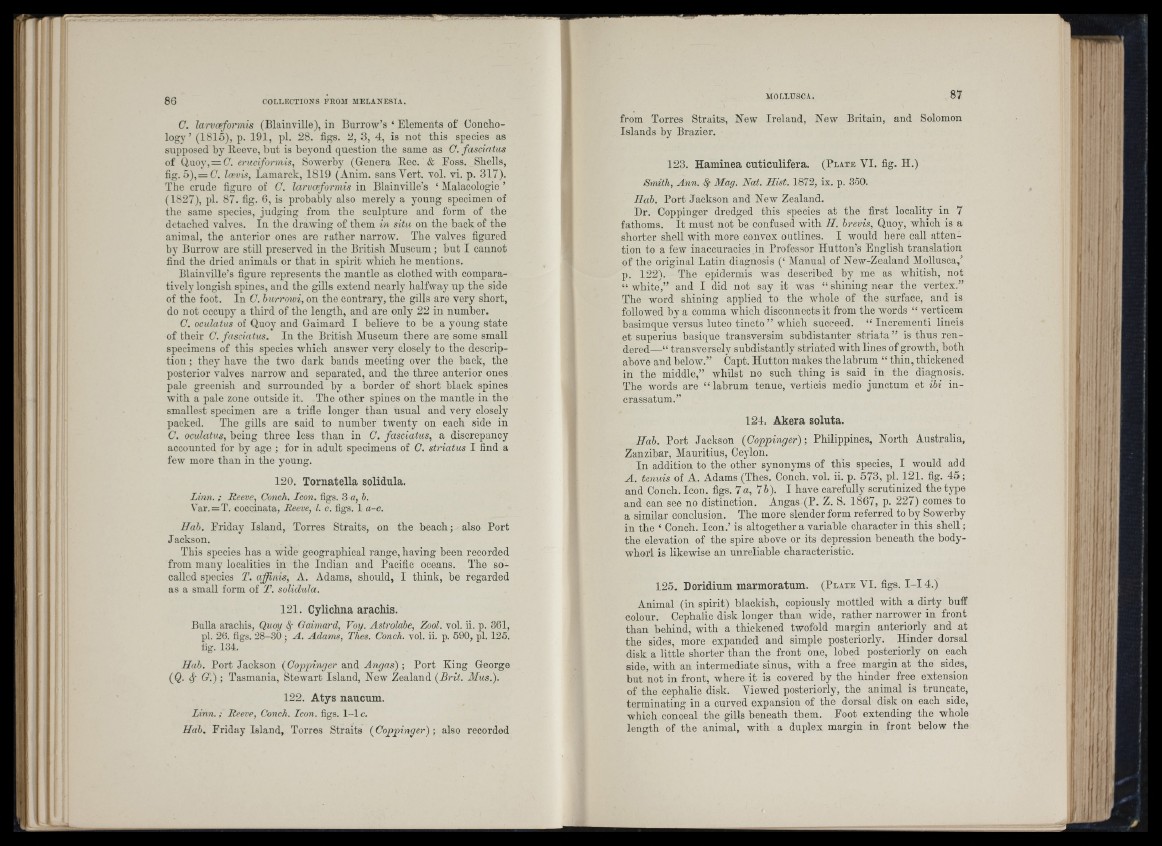
C. larvæformis (Blainville), in Burrow’s ‘ Elements of Concho-
logy’ (1815), p. 191, pi. 28. figs. 2, 3, 4, is not this species as
supposed by lleeve, bnt is beyond question the same as 0. fascia tus
of Quoy, = (7. eruciformis, Sowerhy (Genera Bee. & Foss. Shells,
fig. 5 ) ,= (7. Icevis, Lamarck, 1819 (Anim. sansA*ert. vol. vi. p. 317).
The crude figure of C. larvæformis in Blainville’s ‘ Malacologie ’
(1827), pi. 87. fig. 6, is probably also merely a young specimen of
the same species, judging from the sculpture and form of the
detached valves. In the drawing of them in situ, on the back of the
animal, the anterior ones are rather narrow. The valves figured
by B uitow are still preser^æd in the British Museum ; but I cannot
find the dried animals or th at in spirit which he mentions.
Blainville’s figure represents the mantle as clothed with comparatively
longish spines, and the gills extend nearly halfway up the side
of the foot. In (J. hurrowi, on the contrary, the gills are very short,
do not occupy a third of the length, and are only 22 in number.
(7. oculatus of Quoy and Gaimard I believe to be a young state
of their C. fasciatus. In the British Museum there are some small
specimens of this species which answer very closely to the description
; they have the two dark bands meeting over the back, the
posterior valves narrow and separated, and the three anterior ones
pale greenish and surrounded by a border of short black spines
with a pale zone outside it. Tho other spines on the mantle in the
smallest specimen are a trifle longer than usual and very closely
packed. The gills are said to number twenty on each side in
C. oculatus, being three less than in (7. fasciatus, a discrepancy
accounted for by age ; for in adult specimens of O. striatus I find a
few more than in the young.
120. Tornatella solidula.
Linn. ; Reeve, Conch. Icon. figs. 3 a, b.
Var. =T. coccinata, Reeve, I. c. figs. 1 a-c.
Hah. Friday Island, Torres Straits, on the beach ; also Port
Jackson.
This species has a wide geographical range, having been recorded
from many localities in the Indian and Pacific oceans. The so-
called species T. affinis, A. Adams, should, I think, be regarded
as a small form of T. solidula.
121. Cylichna arachis.
Bulla arachis, Qum/ ^ Gaimard, Voy. Astrolabe, Zool. vol. ii. p. 361,
pi. 26. figs. 28-30 ; A. Adams, Thes. Conch, vol. ii. p. 590, pi. 125.
fig. 134.
Hah. Port Jackson (Ooqopinger and Angas) ; Port King George
(Q. 4' C.) ; Tasmania, Stewart Island, New Zealand (Brit. Mus.).
122. Atys naucnm.
Linn. ; Reeve, Conch. Icon. figs. 1-1 c.
Hab. Friday Island, Torres Straits (Coppinger); also recorded
from Torres Straits, New Ireland, New Britain, and Solomon
Islands by Brazier.
123. Haminea cnticulifera. ( P la te VI. fig. H.)
Smith, Ann. 4- Mag. Nat. Hist. 1872, ix. p. 350.
Uab. Port Jackson and New Zealand.
Dr. Coppinger dredged this species at the first locality in 7
fathoms. I t must not be confused with H. brevis, Quoy, which is a
shorter shell with more convex outlines. I would here call attention
to a few inaccuracies in Professor Hutton’s English translation
of the original Latin diagnosis (‘ Manual of New-Zealand Mollusca,’
p. 122). The epidermis was described by me as whitish, not
“ white',” and I did not say it was “ shining near the vertex.”
The word shining applied to the whole of the surface, and is
followed by a comma which disconnects it from the words “ verticem
basimque versus luteo tincto ” which succeed. “ Increment! lineis
et superius basiqno transversim subdistanter striata ” is thus rendered—“
transversely suhdistantly striated with lines of growth, both
aboA’e and beloAV.” Capt. Hutton makes the labrum “ thin, thickened
in the middle,” whilst no such thing is said in the diagnosis.
The words are “ labrum tenue, verticis medio junetum et ihi in-
crassatum.”
124. Akera solnta.
Hah. Port Jackson (Coppinger); Philippines, North Australia,
Zanzibar, Mauritius, Ceylon.
In addition to the other synonyms of this species, I would add
A . tenuis of A. Adams (Thes. Conch, vol. ii. p. 573, pi. 121. fig. 4 5 ;
and Conch. Icon. figs. l a , 7b). I have carefully scrutinized the type
and can see no distinction. Angas (P. Z. S. 1867, p. 227) comes to
a similar conclusion. The more slender form referred to by Sowerhy
in the ‘ Conch. Icon.’ is altogether a variable character in this shell;
the elevation of the spire above or its depression beneath the body-
whorl is likewise an unreliable characteristic.
'! '
ii '
ii1
125. Doridium marmoratum. ( P la t e VI. figs. I - 1 4.)
An im a l (in spirit) blackish, copiously mottled with a dirty huff
colour. Cephalic disk longer than wide, rather narrower in front
than behind, with a thickened twofold margin anteriorly and at
the sides, more expanded and simple posteriorly. Hinder dorsal
disk a little shorter than the front one, lohed posteriorly on each
side, with an intermediate sinus, with a free margin at tho sides,
but not in front, where it is covered by the hinder free extension
of the cephalic disk. Viewed posteriorly, the animal is truncate,
terminating in a curved expansion of the dorsal disk on each side,
which conceal the gills beneath them. Foot extending the whole
length of the animal, with a duplex margin in front below the
!' 1
t ;
'1 I